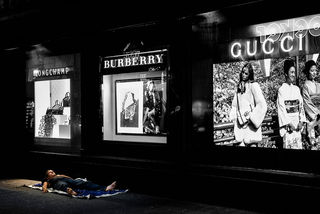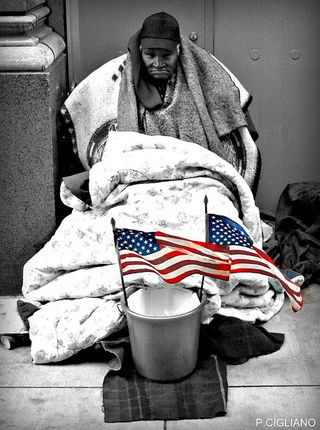Health
Can Income Inequality Make Us Sick?
New research finds that income inequality can hurt both the rich and the poor.
Posted May 4, 2018

This guest post was contributed by Yehsong Kim, a graduate student in the USC Psychology Department's Clinical Science program.
If you’ve ever visited New York City, you’ve undoubtedly marveled at the way that all kinds of people rub shoulders. Towering skyscrapers cast shadows over tiny bodegas. You can spot an investment banker and a high-schooler standing in the same line to grab a slice of pizza for lunch. Well-dressed old women, clergy members, and lawyers briskly walk by homeless people with signs asking for some change. Kids with boomboxes clatter into packed subways and dance for change as adults willfully ignore the loud odes to 1990’s hip-hop by staring at their phones. This melting pot of a city is a marvel, and yet, the faint odor of urine on the streets, the tens of homeless people on any block, the perpetual din of police car sirens hint at a less attractive attribute of this diverse city. New York City can be seen as a caricature of the income inequality pervasive throughout the country: Donald Trump inhabiting the same block as a man sleeping on a park bench. Disturbing though it might be, what does this really have to do with you? Well, these reminders of inequality may be making you sick.
But how can this be? According to the Organisation for Economic Co-operation and Development (OECD), the U.S. spends far more per capita than any other country (an average of $9,892 in 2016), with the next highest spending country, Switzerland, spending almost $2,000 less than the U.S. Well, with that high price tag, the U.S. should be the healthiest country in the world, right? Wrong. The U.S. falls behind dozens of countries in life expectancy and various other health outcomes, and this may be because of our high income inequality, or the gap in income from the richest to the poorest.

While the poorest in any country undoubtedly bear the brunt of health inequities, studies such as one by Lochner and colleagues, show that income inequality hurts everyone, not just the poorest. Hundreds of studies of population health have found this link between higher income inequality and worse health among countries and on the state, county, province-level. A review by Wilkinson and Pickett of 155 papers found that a large majority (70%) suggest that societies with bigger income differences have worse health. In this review, they also found that among 21 rich countries, GDP alone was not related to life expectancy, while income inequality was, suggesting that among wealthier countries, it’s the inequality, not the nation’s overall wealth that’s affecting life expectancy. Moreover, income inequality within a society is not only related to life expectancy, but other health problems including mental illness, obesity, and infant mortality.
This effect, interestingly enough, can be seen as countries close or widen their income inequality gap. For example, Japan and the U.S. saw a reversal in their international rankings of income inequality after WWII, and, you guessed it, in their life expectancy rankings. After WWII, the U.S. had much lower inequality and a high life expectancy rank among other countries, while Japan had high inequality and lower life expectancy. But in the late 1980s, Japan became one of the most equal countries in the world and subsequently had one of the highest life expectancies. The U.S., on the other hand, had increasingly become more unequal starting in the late 1960s to become one of the most unequal societies among developed countries today, with, not surprisingly, a large slip in life expectancy compared to other countries.

So how is income inequality creating these health problems? A study by Kawachi and colleagues found that inequality is socially corrosive, and countries with more inequality have more violence, lower levels of trust, and lower social capital, the features of community-level organization that enable cooperation to help one another, such as civic participation and trust in strangers. This isn’t too hard to imagine. As the rich are getting richer and the poor are getting poorer, distrust builds, crime rates climb. People are now keeping their doors locked at all times; they’re wary of others as they walk briskly through the streets at night. As distrust builds, so does stress with every encounter with a stranger. Social support diminishes, with networks of friendly neighbors and kind strangers shrinking. These social stressors, as they become part of everyday life, lower immune response, elevate blood pressure, affect hormones, impair memory, increase risk of depression, which lead to worse health, and increased risk of mortality in the long run.
So, what does all of this depressing research mean? It’s not all bad news: In fact, if you can see the glass as half full, it’s hopeful news, because income inequality is not fixed. The research gives clear direction to policy makers. It shows that investing our money in healthcare alone has not and will not continue to push forward better health outcomes. While health care is critically important to good health, so is social equity. The U.S. has lagged behind other developed countries in spending in public goods, to the harm of all of its citizens. Pursuing equity pulls us all up to becoming healthier citizens.
So, what can we do? Well, if income inequality is hurting our health by decreasing social capital, we can work to build community trust back up. Join a community garden or borrow a cup of sugar from a neighbor. If you live in a diverse city, make an effort to meet neighbors from across the socioeconomic spectrum. By building up trust and lowering our fears, we are building our social capital. You can also call your representatives or join a local advocacy group. If you’ve never been politically active and it seems like a daunting task, now is a great time to begin participating in our democracy, as more and more people are doing so for the first time. The internet is blooming with great resources. You can simply ask Google or Siri, “How do I contact my local representative?” and off you go.
References
Adler, N. E., & Stewart, J. (2010). Health disparities across the lifespan: Meaning, methods, and mechanisms. Annals of the New York Academy of Sciences, 1186(1), 5-23.
Bezruchka, S., Namekata, T., & Sistrom, M. G. (2008). Interplay of politics and law to promote health: Improving economic equality and health: The case of postwar Japan. American Journal of Public Health, 98(4), 589-594.
Kawachi, I., Kennedy, B. P., Lochner, K., & Prothrow-Stith, D. (1997). Social capital, income inequality, and mortality. American Journal of Public Health, 87(9), 1491-1498.
Lochner, K., Pamuk, E., Makuc, D., Kennedy, B. P., & Kawachi, I. (2001). State-level income inequality and individual mortality risk: A prospective, multilevel study. American Journal of Public Health, 91(3), 385.
OECD. (2018). Health spending. Retrieved from https://data.oecd.org/healthres/health-spending.htm
OECD. (2018). Life expectancy at birth. Retrieved from https://data.oecd.org/healthstat/life-expectancy-at-birth.htm
Wilkinson, R. G., & Pickett, K. E. (2006). Income inequality and population health: A review and explanation of the evidence. Social Science & Medicine, 62(7), 1768-1784.


